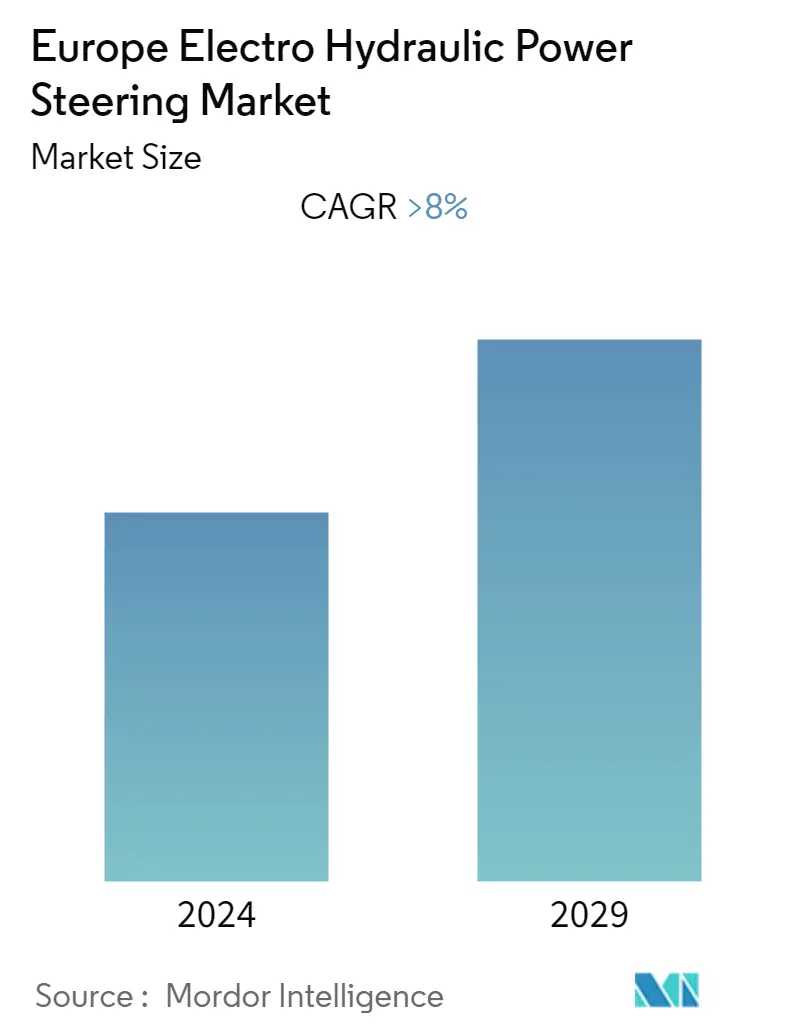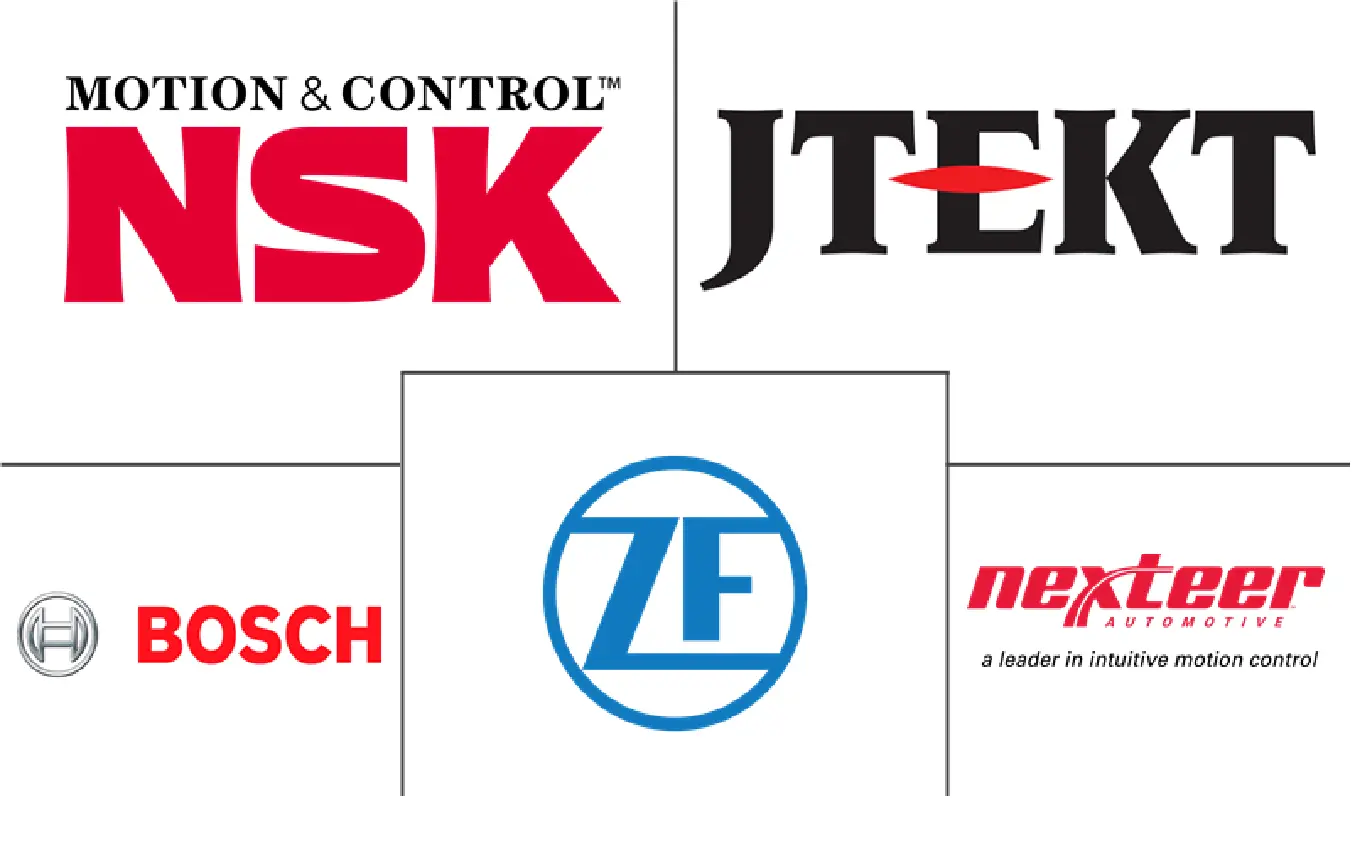Market Size of Europe Electro Hydraulic Power Steering Industry

| Study Period | 2019 - 2029 |
| Base Year For Estimation | 2023 |
| Forecast Data Period | 2024 - 2029 |
| Historical Data Period | 2019 - 2022 |
| CAGR | 8.00 % |
| Market Concentration | Low |
Major Players
*Disclaimer: Major Players sorted in no particular order |
Europe Electro Hydraulic Power Steering Market Analysis
The Europe Automotive Electro-Hydraulic Power Steering Market is anticipated to register a CAGR of over 8% during the forecast period (2020-2025).
As most vehicles nowadays have become heavier and switched to front-wheel drive, along with an increase in tire diameter and width, the effort needed to turn the steering wheel manually would also increase. To reduce the manual effort, power steering or rather power-assisted steering were introduced to assist the driver. An advantage of power steering is its adjustable speed characteristic, where the steering is assisted more at low speed and assisted lightly at high speed to increase the control over the vehicle. This feature has gradually become a commonplace across all new vehicles. Of the different types of steering systems available nowadays, electro-hydraulic power steering is one of them.
Electro-hydraulic hybrid systems allow conventional hydraulic steering to run without the need of an engine-driven hydraulic pump. The hydraulic pressure instead is supplied by an electric motor pump unit that does not draw power from the engine. This concept is particularly helpful in vehicles that utilize conventional hydraulic steering as a basic technology but are also offered for hybrid-electric vehicle variants.
Europe Electro Hydraulic Power Steering Industry Segmentation
The Europe Electro-Hydraulic Power Steering Market report covers a detailed study on the latest trends and innovations in the market which is Segmented by Vehicle Type (Passenger Vehicles and Commercial Vehicles), Component Type (Steering Motor, Sensors, and Others), and Countries. Along with the major players, their strategies, innovations, technological advancements and financials are also covered in the report.
| Component Type | |
| Sensors | |
| Steering Motor | |
| Others |
| Vehicle Type | |
| Passenger Cars | |
| Commercial Vehicle |
| Geography | |
| Germany | |
| United Kingdom | |
| France | |
| Italy | |
| Rest of Europe |
Europe Electro Hydraulic Power Steering Market Size Summary
The Europe Automotive Electro-Hydraulic Power Steering Market is experiencing significant growth, driven by the increasing weight of vehicles and the shift towards front-wheel drive systems. This transition has necessitated the adoption of power-assisted steering systems to reduce the manual effort required to steer, particularly as tire sizes continue to expand. Electro-hydraulic power steering systems, which combine the benefits of hydraulic assistance with electric motor-driven pumps, are becoming more prevalent. These systems offer adjustable steering assistance based on vehicle speed, enhancing control and ease of use. The development of hybrid-electric vehicle variants has further propelled the adoption of these systems, as they provide a more efficient alternative to traditional engine-driven hydraulic pumps.
Despite the advantages of electro-hydraulic systems, the market is witnessing a shift towards fully electronic power steering systems, which eliminate the need for hydraulic pressure altogether. These systems are more efficient and less complex, making them easier to manufacture and maintain. Major automotive manufacturers and OEMs are increasingly investing in electric power steering technologies, which could impact the growth of electro-hydraulic systems. However, electro-hydraulic systems still offer significant fuel savings compared to conventional hydraulic systems, making them attractive for commercial vehicle owners. The market is dominated by a few key players, such as JTEKT Corporation, Nexteer Automotive Group, ZF Friedrichshafen AG, NSK Ltd, and Robert Bosch GmbH, who maintain strong partnerships with major OEMs to secure their market positions.
Europe Electro Hydraulic Power Steering Market Size - Table of Contents
-
1. MARKET DYNAMICS
-
1.1 Market Drivers
-
1.2 Market Restraints
-
1.3 Porters Five Forces Analysis
-
1.3.1 Threat of New Entrants
-
1.3.2 Bargaining Power of Buyers/Consumers
-
1.3.3 Bargaining Power of Suppliers
-
1.3.4 Threat of Substitute Products
-
1.3.5 Intensity of Competitive Rivalry
-
-
-
2. MARKET SEGMENTATION
-
2.1 Component Type
-
2.1.1 Sensors
-
2.1.2 Steering Motor
-
2.1.3 Others
-
-
2.2 Vehicle Type
-
2.2.1 Passenger Cars
-
2.2.2 Commercial Vehicle
-
-
2.3 Geography
-
2.3.1 Germany
-
2.3.2 United Kingdom
-
2.3.3 France
-
2.3.4 Italy
-
2.3.5 Rest of Europe
-
-
Europe Electro Hydraulic Power Steering Market Size FAQs
What is the current Europe Electro Hydraulic Power Steering Market size?
The Europe Electro Hydraulic Power Steering Market is projected to register a CAGR of greater than 8% during the forecast period (2024-2029)
Who are the key players in Europe Electro Hydraulic Power Steering Market?
JTEKT Corporation, Nexteer Automotive Group, ZF, NSK Group and Robert Bosch GmbH are the major companies operating in the Europe Electro Hydraulic Power Steering Market.

